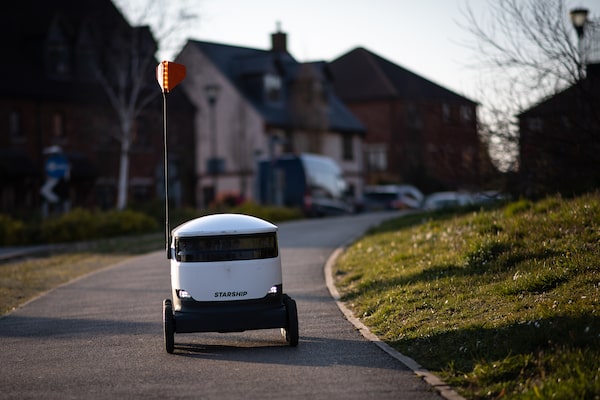
A delivery robot navigates empty paths as it makes a home delivery on March 27, 2020, in Milton Keynes, England.LEON NEAL/Getty Images
For years, auto and tech companies have been been promising that technology will change how we get around.
The future, they say, is self-driving. So far, consumers haven’t been so sure.
In a J.D. Power survey from late last year, consumers reported a “low level of confidence” in AVs.
But the COVID-19 pandemic – and forced physical distancing – might eventually change how we look at AVs.
“In North America, people are quite skeptical of autonomous vehicles; that makes it hard to get them on the road for testing,” says Chris Robinson, a senior analyst with Lux Research. “So if there are a large number of cases showing that AVs are keeping people safe, that could help sway public opinion.”
There are self-driving shuttles and self-driving taxis in trials now, although testing has stopped because of COVID-19.
The case for AVs also hasn’t always been clear. Promoters of the technology say that it will reduce crashes and keep roads safer. But that’s a long way away.
For now, Robinson says that the public remains skeptical, especially after cases such as the one in 2018, when a self-driving Uber vehicle killed an Arizona woman.
That same year, a poll by the Brookings Institution found only 21 per cent of respondents said they were interested in riding in self-driving cars. That was down from previous polls.
Special delivery?
That begs the question: Even if we’re not ready to ride in a self-driving car, could we be more inclined to let self-driving cars carry around our stuff?
With COVID-19 and the need to limit exposure to other people, the idea of AV delivery might start to make more sense.
During the pandemic, many delivery companies are already moving to contactless delivery – where the driver leaves things outside your door, for instance.
Once this is over, the idea of no driver at all might seem like less of a leap.
While we’re not seeing driverless delivery vans yet, there have been examples of AVs helping keep medical personnel safe during the pandemic.
In Florida, the Mayo Clinic has started using Beep, a self-driving shuttle, to transport COVID-19 tests from a drive-thru testing site to a processing laboratory.
That could show a practical use for self-driving shuttles, which until now have mainly been used at airports and tourist attractions, often as a gimmick.
And China-based Neolix, a start-up selling small robo-delivery vans, noticed a surge in orders after its vans were reportedly used to disinfect streets and to deliver food and medical supplies to health-care workers.
A visitor takes a picture of a Neolix self-driving vehicle at the IEEV New Energy Vehicles Exhibition in Beijing on Oct. 18, 2018.THOMAS PETER/Reuters
Even after requirements for physical distancing end, governments may decide that AVs could play an important role in responding to future pandemics.
“So we might see more cities allowing them,” Robinson says. “And that could speed up testing.”
Slowdown for now
With testing stopped right now and no clear answer on when it may start again, AV companies will likely see a temporary setback, Robinson says.
So how long could it be before we see AVs in widespread use? Probably longer than most of us think.
Even with a renewed interest in AVs, Robinson thinks it will be 30-40 years until we’ll see Level 5 AVs, which describes autonomous vehicles that can drive anywhere without a driver.
In order for us to get there, sensors have to get cheaper, cameras have to be improved, and, more importantly, companies and governments have to decide on safety standards.
There are already Level 4 driverless cars, run by companies such as Uber and Waymo. This tier of vehicles operate in geo-fenced areas, where they’re limited to specific roads using GPS. Robinson thinks we might see companies actually make a profit from Level 4 AVs by the end of the decade.
Could the examples of practical uses for AVs now make that adoption happen a little sooner?
It might, but only if we see more examples of AVs being put to a practical use, Robinson says.
“At this point, it’s too early to say what the impact will be on people’s perceptions, but it might make a difference,” Robinson says. “I don’t think we fully know yet what kind of use cases we’ll see.”
Shopping for a new car? Check out the Globe Drive Build and Price Tool to see the latest discounts, rebates and rates on new cars, trucks and SUVs. Click here to get your price.
Stay on top of all our Drive stories. We have a Drive newsletter covering car reviews, innovative new cars and the ups and downs of everyday driving. Sign up for the weekly Drive newsletter, delivered to your inbox for free. Follow us on Instagram, @globedrive.